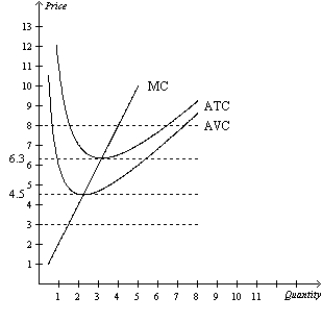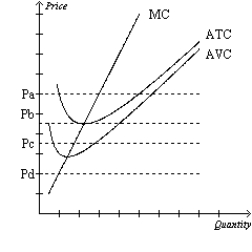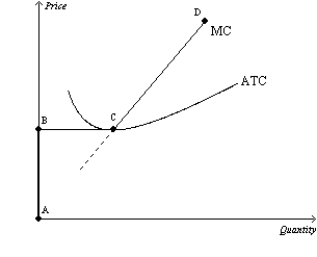A) a small number of buyers and sellers.
B) unique products.
C) the interdependence of firms.
D) free entry and exit by firms.
Correct Answer

verified
Correct Answer
verified
Multiple Choice
Profit maximizing firms in competitive industries with free entry and exit face a price equal to the lowest possible
A) marginal cost of production.
B) fixed cost of production.
C) total cost of production.
D) average total cost of production.
Correct Answer

verified
Correct Answer
verified
Multiple Choice
A firm that exits its market has to pay
A) its variable costs but not its fixed costs.
B) its fixed costs but not its variable costs.
C) both its variable costs and its fixed costs.
D) neither its variable costs nor its fixed costs.
Correct Answer

verified
Correct Answer
verified
True/False
A firm operating in a perfectly competitive market may earn positive, negative, or zero economic profit in the long run.
Correct Answer

verified
Correct Answer
verified
Multiple Choice
When managers of firms in a competitive market observe falling profits, they may infer that the market is experiencing
A) a violation of conventional market forces.
B) over-investment.
C) the entry of new firms.
D) too few firms in the market.
Correct Answer

verified
Correct Answer
verified
Multiple Choice
In a competitive market, no single producer can influence the market price because
A) many other sellers are offering a product that is essentially identical.
B) consumers have more influence over the market price than producers do.
C) government intervention prevents firms from influencing price.
D) producers agree not to change the price.
Correct Answer

verified
Correct Answer
verified
Multiple Choice
Which of the following statements best reflects a price-taking firm?
A) The firm can sell only a limited amount of output at the market price before the market price will fall.
B) If the firm were to charge less than the going price, it would maximize its profits and revenues.
C) If the firm were to charge more than the going price, it would sell none of its goods.
D) Both b and c are correct.
Correct Answer

verified
Correct Answer
verified
Multiple Choice
The competitive firm's long-run supply curve is that portion of the marginal cost curve that lies above average
A) fixed cost.
B) variable cost.
C) total cost.
D) revenue.
Correct Answer

verified
Correct Answer
verified
Multiple Choice
When a competitive firm doubles the quantity of output it sells, its
A) total revenue doubles.
B) average revenue doubles.
C) marginal revenue doubles.
D) profits must increase.
Correct Answer

verified
Correct Answer
verified
Multiple Choice
Which of the following could be used to calculate the profit for a firm?
A) Profit = MR - MC
B) Profit = MR - TC
C) Profit = P - MC) × Q
D) Profit = P - ATC) × Q
Correct Answer

verified
Correct Answer
verified
Multiple Choice
If all firms have the same costs of production, then in long-run equilibrium,
A) price exceeds average total cost for all firms.
B) price exceeds marginal cost for all firms.
C) some firms may earn positive economic profits.
D) all firms have zero economic profits and just cover their opportunity costs.
Correct Answer

verified
Correct Answer
verified
Multiple Choice
Scenario 14-1 Assume a certain firm in a competitive market is producing Q = 1,000 units of output. At Q = 1,000, the firm's marginal cost equals $15 and its average total cost equals $11. The firm sells its output for $12 per unit. -Refer to Scenario 14-1. At Q = 999, the firm's profits equal
A) $993.
B) $997.
C) $1,003.
D) $1,007.
Correct Answer

verified
Correct Answer
verified
Multiple Choice
A key characteristic of a competitive market is that
A) government antitrust laws regulate competition.
B) producers sell nearly identical products.
C) firms minimize total costs.
D) firms have price setting power.
Correct Answer

verified
Correct Answer
verified
Multiple Choice
Suppose a firm in a competitive market produces and sells 150 units of output and earns $1,800 in total revenue from the sales. If the firm increases its output to 200 units, total revenue will be
A) $2,000.
B) $2,400.
C) $4,200.
D) We do not have enough information to answer the question.
Correct Answer

verified
Correct Answer
verified
Multiple Choice
Figure 14-1
Suppose that a firm in a competitive market has the following cost curves:  -Refer to Figure 14-1. If the market price is $4.00, the firm will earn
-Refer to Figure 14-1. If the market price is $4.00, the firm will earn
A) positive economic profits in the short run.
B) negative economic profits in the short run but remain in business.
C) negative economic profits and shut down.
D) zero economic profits in the short run.
Correct Answer

verified
Correct Answer
verified
Multiple Choice
Figure 14-2
Suppose a firm operating in a competitive market has the following cost curves:  -Refer to Figure 14-2. Which of the four prices corresponds to a firm earning negative economic profits in the short run but trying to remain open?
-Refer to Figure 14-2. Which of the four prices corresponds to a firm earning negative economic profits in the short run but trying to remain open?
A) Pa
B) Pb
C) Pc
D) Pd
Correct Answer

verified
Correct Answer
verified
Multiple Choice
Figure 14-11  -Refer to Figure 14-11. The figure above is for a firm operating in a competitive industry. If there were eight identical firms in the industry, which of the following price-quantity combinations would be on the market supply curve?
-Refer to Figure 14-11. The figure above is for a firm operating in a competitive industry. If there were eight identical firms in the industry, which of the following price-quantity combinations would be on the market supply curve? 
A) A only
B) A and C only
C) B only
D) B and D only
Correct Answer

verified
Correct Answer
verified
Multiple Choice
Table 14-9
Suppose that a firm in a competitive market faces the following revenues and costs:
 -Refer to Table 14-9. If the firm produces 3 units of output,
-Refer to Table 14-9. If the firm produces 3 units of output,
A) marginal cost is $4.
B) total revenue is greater than variable cost.
C) marginal revenue is less than marginal cost.
D) the firm is maximizing profit.
Correct Answer

verified
Correct Answer
verified
True/False
In a competitive market, firms are unable to differentiate their product from that of other producers.
Correct Answer

verified
Correct Answer
verified
Multiple Choice
Figure 14-9
Suppose a firm operating in a competitive market has the following cost curves:  -Refer to Figure 14-9. Which line segment best reflects the long-run supply curve for this firm?
-Refer to Figure 14-9. Which line segment best reflects the long-run supply curve for this firm?
A) ABCD
B) BC
C) ABC
D) None of the above is correct. We must know the firm's average variable cost.
Correct Answer

verified
Correct Answer
verified
Showing 521 - 540 of 543
Related Exams